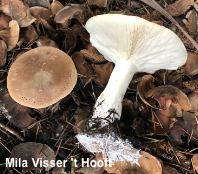| Major Groups > Gilled Mushrooms > Pale-Spored > Leucopaxillus > Leucopaxillus gentianeus |

|
Leucopaxillus gentianeus [ Basidiomycota > Agaricales > Tricholomataceae > Leucopaxillus . . . ] by Michael Kuo When fresh and young, this western Leucopaxillus is easily separated from other species in the genus on the basis of its cap color, which is dark liver brown—but older, faded specimens of Leucopaxillus gentianeus can be more or less indistinguishable from other mushrooms in the Leucopaxillus albissimus complex, and beginners might confuse even the young specimens with a variety of superficially similar mushrooms (including species of Tricholoma and Russula; see the list of features on the page for the genus Leucopaxillus for help eliminating these contenders). Microscopic features separating Leucopaxillus gentianeus include the spore dimensions (see below) and the presence of encrusting brown pigments on the hyphae of the pileipellis. Singer & Smith (1943) document 10 forms and "subforms" (?!) of Leucopaxillus amarus (the former name for Leucopaxillus gentianeus), primarily on the basis of taste, degree of pigmentation, and size. You are welcome to go down that road if you'd like (ask your library to procure Papers of the Michigan Academy of Science 28: 85–132), but I have a feeling you have better things to do. Thanks to Mila Visser 't Hooft for documenting, collecting, and preserving Leucopaxillus gentianeus for study; her collection is deposited in The Herbarium of Michael Kuo. Description: Ecology: Saprobic, decomposing the litter of conifers; growing scattered, gregariously, or in arcs or fairy rings; summer, fall, and, in warmer climates, winter; widely distributed and common in North America from the Rocky Mountains westward and southward into Mexico; also known from Central America, Australia, and Europe. The illustrated and described collections are from California and Colorado. Cap: 3–15 cm; convex with an inrolled margin when young, becoming broadly convex or nearly flat; dry; bald, but with a kid-leathery feel; reddish brown to orangish brown when young, but often fading with age to tan; the margin sometimes becoming widely lined at maturity. Gills: Attached to the stem or beginning to run down it; close or crowded; short-gills frequent; separable from the cap as a layer; white. Stem: 3–10 cm long; 1–2 cm thick; more or less equal; dry; bald; white, discoloring brownish; with prominent and copious basal mycelium. Flesh: White; not changing when sliced. Odor and Taste: Odor strongly mealy; taste bitter. Chemical Reactions: KOH olive on pigmented cap surfaces; negative on faded caps. Spore Print: White. Microscopic Features: Spores 4–6 x 3–4 µm; broadly ellipsoid to nearly subglobose; spiny with spines less than 0.5 µm high; amyloid. Lamellar trama more or less parallel. Basidia 4-sterigmate. Pleurocystidia not found. Cheilocystidia 20–40 x 1–4 µm; cylindric-flexuous, fusiform, or slightly irregular; hyaline and smooth in KOH. Pileipellis a cutis; yellowish or brown in KOH; elements 5–7.5 µm wide, clamped, smooth or encrusted with brown pigment; terminal cells cylindric with rounded apices. REFERENCES: (Quélet, 1873) Kotlaba, 1966. (Saccardo, 1887; Singer & Smith, 1943; Smith, 1975; Smith, Smith & Weber, 1979; Arora, 1986; States, 1990; Phillips, 1991/2005; Lincoff, 1992; Miller & Miller, 2006; Trudell & Ammirati, 2009; Desjardin, Wood & Stevens, 2015; Evenson, 2016; Siegel & Schwarz, 2017; Læssøe & Petersen, 2019.) Herb. Kuo 01140502, 08120801, 01152003. This site contains no information about the edibility or toxicity of mushrooms. |
© MushroomExpert.Com |
|
Cite this page as: Kuo, M. (2020, February). Leucopaxillus gentianeus. Retrieved from the MushroomExpert.Com Web site: http://www.mushroomexpert.com/leucopaxillus_gentianeus.html |







